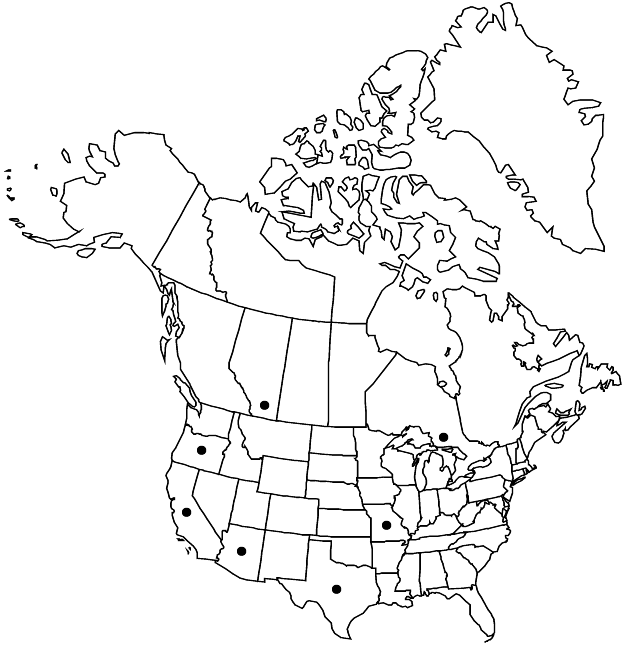Difference between revisions of "Rumex dentatus"
Mant. Pl., 226. 1771.
FNA>Volume Importer |
imported>Volume Importer |
||
| Line 8: | Line 8: | ||
}} | }} | ||
|common_names=Toothed or dentate or Indian dock | |common_names=Toothed or dentate or Indian dock | ||
| + | |special_status={{Treatment/ID/Special_status | ||
| + | |code=I | ||
| + | |label=Introduced | ||
| + | }} | ||
|basionyms= | |basionyms= | ||
|synonyms= | |synonyms= | ||
| Line 24: | Line 28: | ||
|elevation=0-300 m | |elevation=0-300 m | ||
|distribution=Alta.;Ont.;Ariz.;Calif.;Mo.;Oreg.;Tex.;se Europe;tropical and subtropical Asia;n Africa;introduced elsewhere. | |distribution=Alta.;Ont.;Ariz.;Calif.;Mo.;Oreg.;Tex.;se Europe;tropical and subtropical Asia;n Africa;introduced elsewhere. | ||
| + | |introduced=true | ||
|discussion=<p><i>Rumex dentatus</i>, belonging to subsect. Dentati Rechinger f. (K. H. Rechinger 1937), is an extremely variable species. In Eurasia and northern Africa it is represented by several distinct races, usually regarded as subspecies. Rechinger reported from North America (California and Oregon, mostly as a casual alien occuring in ballast grounds) only subsp. klotzschianus (Meisner) Rechinger f., which is native in southern and eastern Asia (China, India, Japan, Korea). J. E. Dawson (1979) also regarded this as the most common subspecies in North America. However, I believe most North American representatives of this aggregate belong to subsp. halacsyi (Rechinger f.) Rechinger f., which is native in the eastern Mediterranean region (Asia Minor), the Caucasus, southeastern Europe, and western and central Asia. This subspecies, sometimes recognized as R. halacsyi Rechinger f., differs from subsp. klotzschianus by its broader triangular (not rounded) inner tepals and longer teeth (to 3 mm). Unfortunately, subspecies of <i>R. dentatus</i> still are insufficiently understood even in Eurasia. It would be premature to assign most North American specimens to any infraspecific entity.</p> | |discussion=<p><i>Rumex dentatus</i>, belonging to subsect. Dentati Rechinger f. (K. H. Rechinger 1937), is an extremely variable species. In Eurasia and northern Africa it is represented by several distinct races, usually regarded as subspecies. Rechinger reported from North America (California and Oregon, mostly as a casual alien occuring in ballast grounds) only subsp. klotzschianus (Meisner) Rechinger f., which is native in southern and eastern Asia (China, India, Japan, Korea). J. E. Dawson (1979) also regarded this as the most common subspecies in North America. However, I believe most North American representatives of this aggregate belong to subsp. halacsyi (Rechinger f.) Rechinger f., which is native in the eastern Mediterranean region (Asia Minor), the Caucasus, southeastern Europe, and western and central Asia. This subspecies, sometimes recognized as R. halacsyi Rechinger f., differs from subsp. klotzschianus by its broader triangular (not rounded) inner tepals and longer teeth (to 3 mm). Unfortunately, subspecies of <i>R. dentatus</i> still are insufficiently understood even in Eurasia. It would be premature to assign most North American specimens to any infraspecific entity.</p> | ||
|tables= | |tables= | ||
| Line 47: | Line 52: | ||
|publication title=Mant. Pl., | |publication title=Mant. Pl., | ||
|publication year=1771 | |publication year=1771 | ||
| − | |special status= | + | |special status=Introduced |
| − | |source xml=https:// | + | |source xml=https://bibilujan@bitbucket.org/aafc-mbb/fna-data-curation.git/src/bb6b7e3a7de7d3b7888a1ad48c7fd8f5c722d8d6/coarse_grained_fna_xml/V5/V5_1079.xml |
|subfamily=Polygonaceae subfam. Polygonoideae | |subfamily=Polygonaceae subfam. Polygonoideae | ||
|genus=Rumex | |genus=Rumex | ||
Revision as of 23:29, 27 May 2020
Plants annual, rarely biennial, glabrous or indistinctly papillose especially on veins of leaf blades abaxially, with fusiform, vertical rootstock. Stems erect, often flexuous in inflorescence, branched distal to middle, occasionally almost from base, 20–70(–80) cm. Leaves: ocrea deciduous or partially persistent at maturity; blade oblong, elliptic-lanceolate, or ovate-elliptic, 3–8(–12) × 2–5 cm, normally less than 4 times as long as wide, not coriaceous, base normally truncate or subcordate to weakly cordate, margins entire, flat to weakly undulate, occasionally slightly crisped, apex obtuse or subacute. Inflorescences terminal, occupying distal 1/2 of stem, usually lax and interrupted, broadly paniculate, branches usually ascending and straight. Pedicels articulated in proximal 1/3, filiform, 2–5 mm, articulation distinctly swollen. Flowers 10–20 in rather dense remote whorls; inner tepals ovate-triangular or deltoid, 3–5.5(–6) × 2–3 mm (excluding teeth), ca. 1.5 times as long as wide, base truncate, margins in most cases distinctly dentate, very rarely subentire, apex acute to subacute, straight, teeth 2–4(–5), normally at each side of margins, narrowly triangular, straight, 1–3(–5) mm, equaling or shorter than width of inner tepals; tubercles (1–)3, equal or subequal. Achenes dark reddish brown, 2–2.8 × 1.4–1.8 mm. 2n = 40.
Phenology: Flowering late spring–summer.
Habitat: Waste places, shores, cultivated fields
Elevation: 0-300 m
Distribution

Introduced; Alta., Ont., Ariz., Calif., Mo., Oreg., Tex., se Europe, tropical and subtropical Asia, n Africa, introduced elsewhere.
Discussion
Rumex dentatus, belonging to subsect. Dentati Rechinger f. (K. H. Rechinger 1937), is an extremely variable species. In Eurasia and northern Africa it is represented by several distinct races, usually regarded as subspecies. Rechinger reported from North America (California and Oregon, mostly as a casual alien occuring in ballast grounds) only subsp. klotzschianus (Meisner) Rechinger f., which is native in southern and eastern Asia (China, India, Japan, Korea). J. E. Dawson (1979) also regarded this as the most common subspecies in North America. However, I believe most North American representatives of this aggregate belong to subsp. halacsyi (Rechinger f.) Rechinger f., which is native in the eastern Mediterranean region (Asia Minor), the Caucasus, southeastern Europe, and western and central Asia. This subspecies, sometimes recognized as R. halacsyi Rechinger f., differs from subsp. klotzschianus by its broader triangular (not rounded) inner tepals and longer teeth (to 3 mm). Unfortunately, subspecies of R. dentatus still are insufficiently understood even in Eurasia. It would be premature to assign most North American specimens to any infraspecific entity.
Selected References
None.